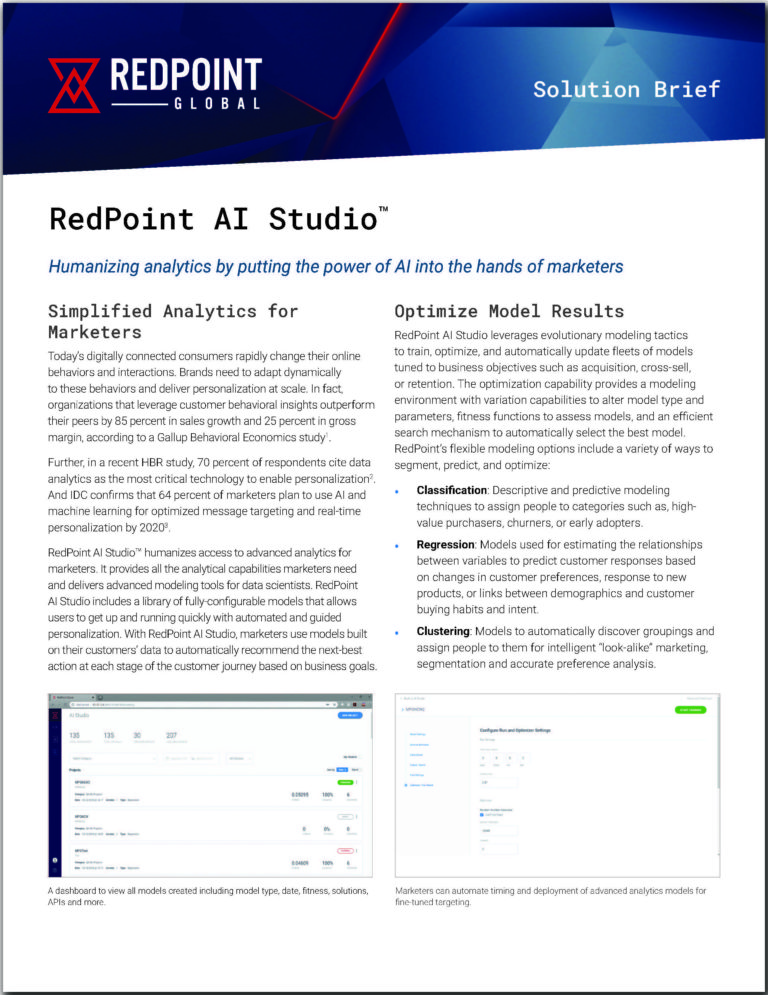 Data scientists who support marketing must do more today than just build models and provide reports. It’s essential that they understand the importance of customer experience and can act as storytellers, translating data into insight that marketers can use to deliver a superior customer experience (CX) — one that is relevant and personalized.
Data scientists who support marketing must do more today than just build models and provide reports. It’s essential that they understand the importance of customer experience and can act as storytellers, translating data into insight that marketers can use to deliver a superior customer experience (CX) — one that is relevant and personalized.
The fact is, customers expect and enjoy personalized customer experiences. The LoyaltyOne study “CX: Intention vs. Impact” states that 76 percent of consumers say receiving personalized discount offers based on their purchase history is important. Also, according to a study from Marketing Insider Group, 78 percent of consumers polled say personally relevant content increases their purchase intent. Data enables marketers to better understand customers and deliver the types of experiences customers expect. So, by extension, the data scientists and analysts that support marketers also need to be concerned with CX.
Working together, data scientists and marketers can develop a holistic view of the customer using tools that create a single-point-of-control over data and interactions and provide marketers access to the data they need in real time. With the right customer-centric processes and technology in place, marketers are more likely to meet customers’ exacting demands for personalized experiences.
Why CX Now?
A recent Gartner CMO Spend Survey 2018-2019 revealed that customer capabilities, such as customer experience (CX), dominate CMOs’ list of skills they feel are vital to deliver a strong, cohesive marketing strategy. Using CX to gain a competitive edge requires a consistent approach across the enterprise, and across all customer touchpoints. Hence the importance of greater collaboration between the analytics and marketing teams. The benefits are already evident. According to research firm Aberdeen’s report “Customer Experience Agenda 2018,” top performers in terms of CX retain 45 percent more customers year-over-year than other companies (85 percent versus 58 percent). And, top performers grow customer profit margins year-over-year by nearly 40 percent.
Those top performers are in the minority of businesses, so now’s the time to make the changes needed to provide a superior CX to gain a long-lasting competitive advantage. The only way to achieve that CX-based competitive advantage and be a top CX performer is by delivering a consistent and contextually relevant omnichannel experience — because that connected experience is what most customers now want. According to the “Wantedness” study by marketing agency Wunderman, 63 percent of U.S. consumers consider great brands as the ones that exceed their expectations across the entire customer journey.
This evolving competitive landscape and need for holistic customer experiences actually presents an opportunity: Deliver a superior customer experience across every interaction touchpoint and all along the customer journey by engaging on customers’ terms in their preferred channels. Marketers can’t do this without the help of data scientists.
Data scientists and marketers must collaborate to create a single-point-of-control over data and interactions — one that provides a holistic customer view, connecting customer data from across sources: batch and streaming, internal and external, structured and unstructured, transactional and demographic.
Creating a single-point-of-control over data allows data scientists to work with marketers to develop a deep understanding of the customer and deploy the models and personalization strategies that have maximum impact. Then marketers can align that insight with their omnichannel strategy and deliver highly personalized experiences at speed and scale. A single-point-of-control over interactions is necessary to orchestrate those interactions in today’s omnichannel environment, ones that span multi-stage real-time and offline customer journeys.
CX Foundations
Building this environment means that data scientists and marketers need to think more like customers: Customers have always viewed the companies they do business with as one unit, not a group of silos they have to interact with individually. Data scientists and marketers need to shift from a silo mind-set that leads to fragmented experiences to one that is centered on connecting disparate touchpoints in a way that weaves each discreet interaction into a cohesive whole.
This new, connected reality has two foundational elements that will enable a deep understanding of customers’ needs, expectations, and channel preferences, so marketers can then deliver consistent and contextually relevant omnichannel experiences: customer insight and customer interactions.
Customer insight to meet today’s CX expectations takes…
– Holistic view of the customer
– Real-time data access
– Single-point-of-control over data
Customer interaction to meet today’s CX expectations takes….
– Understanding where a customer is in their path-to-purchase
– Decisioning for the next best action (e.g. offer, message or content)
– Orchestrating the right actions in customers’ preferred cadence and channel(s)
Optimizing and personalizing omnichannel customer experiences to meet customer expectations requires organizational, process, and technology changes that bridge silos and center on the customer. Again, the ideal method for enabling all this is to create a single point of control over data and for real-time interactions, and phasing in process and organizational changes over time. The single-point-of-control acts as a central hub from which data scientists can provide insight and marketers can make decisions that are then feed to the channels. It comprises a single-point-of -control for aggregating and understanding customer data, as well as a single-point-of-intelligent-control over customer interactions that spans across every enterprise touchpoint.
The ideal technology to support a single-point-of-control is a customer engagement platform that comprises a Customer Data Platform (CDP) and an interaction hub. The combination of these tools allows data scientists and marketers know all that is knowable about their customers, so it’s possible to recognize a customer across multiple channels and interaction touchpoints. This allows marketers to then deliver relevant, hyper-personalized offers at any touchpoint in real time.
Both the current competitive landscape and the rise of the empowered consumer have made it clear that data scientists need to take a new different approach to working with their peers in marketing. Using a single-point-of-control enables data scientists to help marketers get the insight they need to hyper-personalized customer journeys in the context and cadence of the customer and set their brand apart from the competition — a win/win for customer and company.
RELATED ARTICLES
Art of the Possible – The Role Data Can Play in Unlocking Marketing Creativity
A New Way for Marketers to Leverage Data for Omnichannel Marketing
What is the Future of Marketing?

